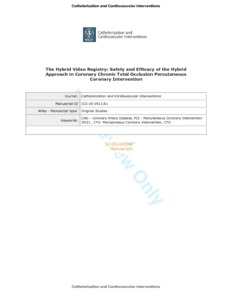Daniels, DV;
Banerjee, S;
Alaswad, K;
Doing, AH;
Dattilo, PB;
Kalyanasundaram, A;
Spratt, JC;
Hanratty, CG;
Strange, JW;
Walsh, S;
et al.
Daniels, DV; Banerjee, S; Alaswad, K; Doing, AH; Dattilo, PB; Kalyanasundaram, A; Spratt, JC; Hanratty, CG; Strange, JW; Walsh, S; Lombardi, WL; Aaron Grantham, J
(2018)
Safety and efficacy of the hybrid approach in coronary chronic total occlusion percutaneous coronary intervention: The Hybrid Video Registry.
Catheterization and Cardiovascular Interventions, 91 (2).
pp. 175-179.
ISSN 1522-1946
https://doi.org/10.1002/ccd.26501
SGUL Authors: Spratt, James
![[img]](http://sgultest.da.ulcc.ac.uk/110224/1.hassmallThumbnailVersion/Hybrid%20video%20registry.pdf)  Preview |
|
PDF
Accepted Version
Available under License ["licenses_description_publisher" not defined].
Download (381kB)
| Preview
|
Abstract
Objectives
The aim of the Hybrid Video Registry (HVR) is to assess the acute safety and efficacy of the Hybrid Approach in comparison to other contemporary methods of CTO‐PCI. Background: Recently, multiple techniques in Percutaneous Coronary Intervention (PCI) for coronary Chronic Total Occlusions (CTO) have been synthesized into a method referred to as the “Hybrid Approach”.
Methods
About 194 video‐taped timed live cases from CTO‐PCI training workshops were analyzed by independent data abstractors and compared to three contemporary CTO‐PCI registries stratified by case complexity based on the J‐CTO score.
Results
Overall procedural success was 95% of all cases attempted with an excellent safety profile. In the most complex lesion subset, which made up 45% of all HVR cases, success was 92.8%, which was significantly higher than either the Royal Bromptom (78.9%), or Japanese‐CTO (73.3%) registries, P = 0.04 Hybrid vs. Royal Brompton, P = 0.006 Hybrid vs. Japanese‐CTO). The Hybrid Approach was also associated with shorter procedure times and lower contrast utilization.
Conclusions
In a real world angiographic registry of complex CTOs, the Hybrid Approach to CTO‐PCI is safe, and may be superior to other contemporary approaches to CTO intervention with respect to procedural success and efficiency among a diverse group of operators and lesion complexity.
| Item Type: |
Article
|
| Additional Information: |
This is the peer reviewed version of the following article: Daniels, D. V., Banerjee, S. , Alaswad, K. , Doing, A. H., Dattilo, P. B., Kalyanasundaram, A. , Spratt, J. C., Hanratty, C. G., Strange, J. W., Walsh, S. , Lombardi, W. L. and Aaron Grantham, J. (2018), Safety and efficacy of the hybrid approach in coronary chronic total occlusion percutaneous coronary intervention: The Hybrid Video Registry. Cathet. Cardiovasc. Intervent., 91: 175-179., which has been published in final form at https://doi.org/10.1002/ccd.26501. This article may be used for non-commercial purposes in accordance with Wiley Terms and Conditions for Use of Self-Archived Versions. |
| Keywords: |
1102 Cardiovascular Medicine And Haematology, Cardiovascular System & Hematology |
| SGUL Research Institute / Research Centre: |
Academic Structure > Molecular and Clinical Sciences Research Institute (MCS) |
| Journal or Publication Title: |
Catheterization and Cardiovascular Interventions |
| ISSN: |
1522-1946 |
| Dates: |
| Date | Event |
|---|
| 6 February 2018 | Published | | 29 November 2017 | Published Online | | 23 February 2016 | Accepted |
|
| Publisher License: |
Publisher's own licence |
| URI: |
http://sgultest.da.ulcc.ac.uk/id/eprint/110224 |
| Publisher's version: |
https://doi.org/10.1002/ccd.26501 |
Statistics
Item downloaded times since 10 Oct 2018.
Actions (login required)
 |
Edit Item |


